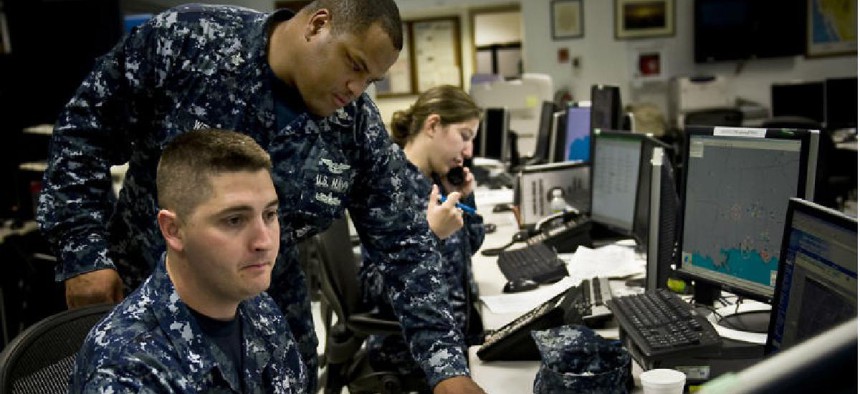Navy shifts to zero trust mindset to deal with COVID-related telework
Yesterday's buzzword has become today's security imperative, according to the department's CISO.
The Navy's top cyber official said he expects the department to move "aggressively" towards a zero trust security model to secure government systems while a critical mass of employees continues work from home and log in from personal devices due to the COVID-19 pandemic.
Shortly after the virus started spreading across the U.S., the Navy set up an internal collaboration tool called Commercial Virtual Response, according to Chief Information Security Officer Chris Cleary. While operational and classified work was still routed through secure facilities, the tool allowed hundreds of thousands of Navy employees to continue working while under stay-at-home orders by accessing agency information through the cloud on their government, mobile or even personal device.
The tool allowed many projects to continue functioning on the fly and the experience has taught the Navy the value of setting up a new, broader security architecture.
"I think you're going to see the Navy, based on COVID, aggressively pursue zero trust," said Cleary during a July 27 webcast hosted by FireEye. "It was something that was being kicked around as the latest buzzword a year ago, but now it's really moved to the top the stack, principally to enable this telework problem."
Zero trust – a model of cybersecurity built on the assumptions that there is no meaningful network perimeter and that access controls should be tightly regulated and monitored even for high-level employees – has been steadily gaining popularity within private and public sector organizations over the past decade.
Government auditors say federal agencies still remain tethered to an outdated concept; namely that the best way to protect data is by shifting defensive resources toward the network boundary.
"We find that for most federal agencies, most of their tools -- 80% -- are focused at the perimeter, which is basically the initial exploitation phase," said Gary Austin, assistant director at the Center for Enhanced Cybersecurity at the Government Accountability Office. "We have not seen a lot of in the security stack of most agencies in terms of knowing the post-exploitation activities, the visibility inside your network, network session data and metadata."
Much of GAO's job involves prodding agencies to focus less on those front-end activities and more on the entire cyber kill chain. One that needs to improvement: monitoring what's happening within the network boundary, particularly around insider threats. Former Air Force Maj. Gen. Earl Matthews, now a vice president of strategy at Mandiant, estimated that 80% a typical organization's network traffic is between employees.
Austin said in all the reviews he's done for the federal government since 2015, he has yet to encounter a blue team dedicated to identifying and fixing security flaws.
"The security groups generally don't have a voice [at leadership meetings], that's what we've seen in terms of convincing the C-level executive how important these issues are," said Austin.
He attributed the problem to a lack of security governance within the c-suite at many agencies, along with an unhealthy emphasis on buying tools without a solid understanding of how they fit into broader strategies. For example, some agencies have turned to machine learning sensors in order to monitor their network activity. However, they often fail to set up the corresponding data feeds that largely power and guide the accuracy of such algorithms.
Cleary lamented that acquisition offices are often skipped over when it comes to sharing threat intelligence, even though they are responsible for evaluating and buying IT and security tools. Operating this way for decades has put the Navy in a position where it must now "scrap things that we realized were engineered without cybersecurity in it [or] figure out how to put cybersecurity in things that already exist."
Such cultural concerns can go in the other direction as well. While the Navy has plenty of dedicated cybersecurity personnel, digital weaknesses can still be more difficult to spot for the rank and file than some of the more straightforward, tangible problems they're used to dealing with.
"Some of these vulnerabilities or risks that are associated with our information systems aren't as readily apparent as something as visible as water coming in through a hole on the side of a ship," Cleary said. "So it's not necessarily reacted to until it becomes a problem."
Institutional memory is also short. Teaching employees basic cyber hygiene concepts like how to spot spotting phishing emails is important, as most breaches often start with some form of credential theft. Retaining those lessons has proven to be substantially harder.
"If we go in and do a review of an agency, we come back three or four years later [and] we're back to square one. We're still seeing those same cyber hygiene issues," said Austin.
This article first appeared on FCW, a Defense Systems partner site.




